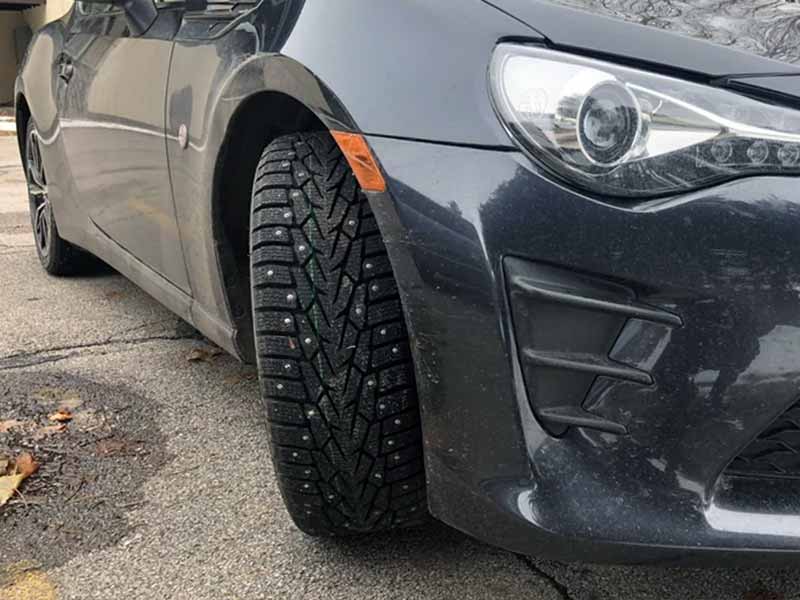Have you ever wondered how fast you can safely drive with studded tires during those icy winter months? If you’re someone who faces snowy and icy roads, understanding the capabilities and limitations of studded tires is crucial for your safety and vehicle’s performance.
How Fast Can You Drive With Studded Tires?
Specific speed recommendations for studded tires can vary. It’s generally advised to not exceed 45-50 mph. These tires are optimized for traction on icy surfaces rather than high-speed driving. The safe driving speed with studded tires largely depends on road conditions
In this article, we’ll explore the specifics of studded tires, including their speed limitations, effectiveness on highways, wear and tear considerations, legal aspects, and alternatives for winter driving.
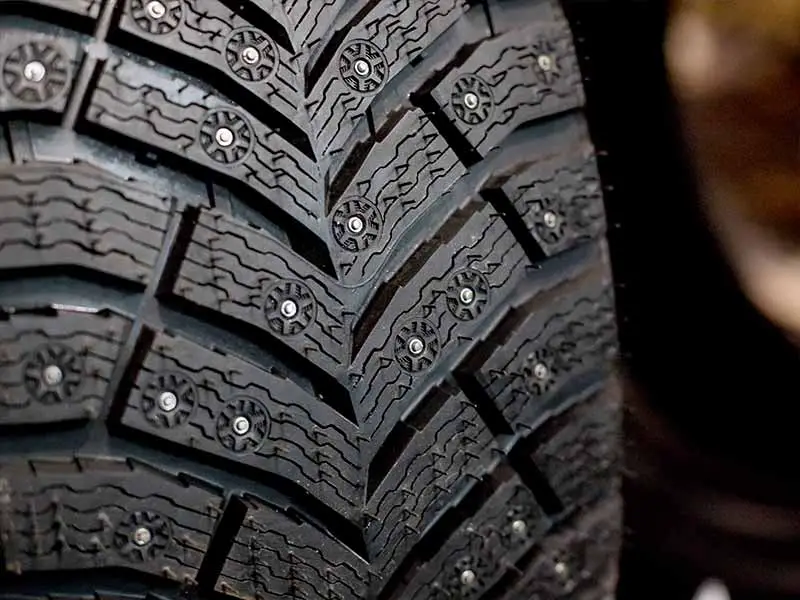
Speed Limitations with Studded Tires
While studded tires are excellent for winter traction, they are not designed for high-speed driving. It’s important to adhere to recommended speed limits and drive according to road conditions. Remember, the goal is to reach your destination safely, not quickly.
General Speed Recommendations for Studded Tires
Studded tires are designed for traction, not speed. When you’re driving with these tires, it’s important to know that:
- Lower Speeds Are Safer: Generally, it’s recommended to drive at lower speeds with studded tires. This is because the studs provide grip by digging into ice, which works best at moderate speeds.
- Manufacturer Guidelines: Always check the tire manufacturer’s recommendations. They usually specify a maximum safe speed for their studded tires.
Top Speed of Snow Tires
When talking about the ‘top speed’ of snow tires, remember that studded tires and regular snow tires are different. For studded tires:
- Top Speed Limit: They are often rated for lower top speeds compared to regular snow tires. This is due to their design focusing on grip rather than high-speed performance.
- Driving at High Speeds: At higher speeds, studded tires may not perform as well. The studs can become less effective, and the ride might be less smooth.
Impact of Tire Studs on Performance
The metal studs in these tires have a specific role, but they also affect how the tire behaves on the road:
- Noise and Vibration: At higher speeds, studded tires can be noisier and cause more vibration.
- Road Surface: On clear roads, the studs can feel bumpy and less comfortable compared to driving on ice or snow.
Safety First
As an enthusiast and expert, I always prioritize safety. With studded tires, this means:
- Adapting to Conditions: Adjust your speed based on road conditions. Even with studded tires, icy roads can be unpredictable.
- Regular Checks: Keep an eye on the condition of your studs and tires. Worn-out studs or tires can affect your driving safety.
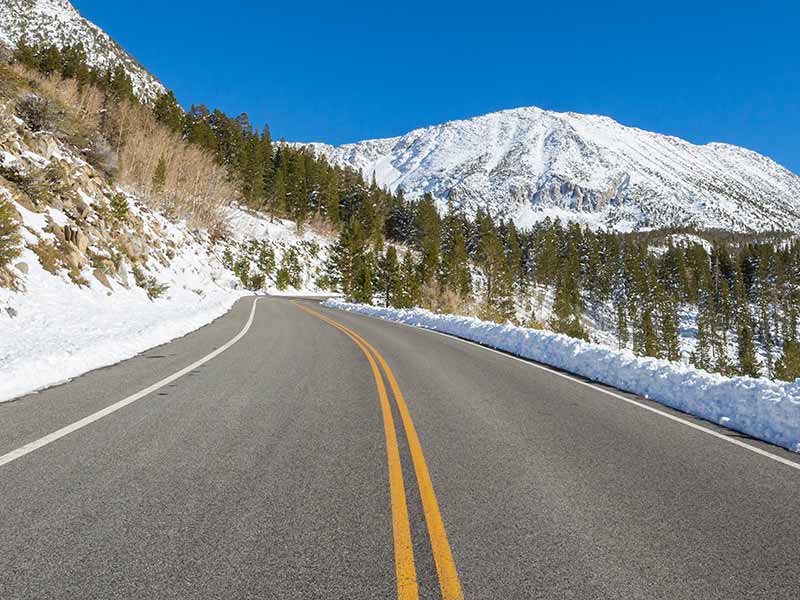
Highway Driving with Studded Tires
While you can use studded tires on highways, it’s important to be aware of legal restrictions, speed limitations, and safety considerations. Always prioritize your safety and the safety of others on the road.
Let’s dive into what you need to know about using studded tires on highways.
Can You Drive on the Highway with Studded Tires?
The short answer is yes, you can drive on the highway with studded tires, but there are important things to consider:
- Legal Restrictions: Some regions have specific laws about using studded tires on highways. It’s essential to check your local regulations to ensure you’re not breaking any rules.
- Speed Limits: Even if it’s legal to use studded tires on highways, remember that these tires are not designed for high speeds. Adhering to a moderate speed is safer and helps maintain the integrity of the tires.
Safety Considerations on Highways
When driving with studded tires on highways, safety should be your top priority:
- Increased Stopping Distance: Studded tires can increase your stopping distance on dry or wet roads. Be mindful of this, especially in highway traffic.
- Road Conditions: Studded tires are most effective on icy or snow-covered roads. If the highway is clear, the benefits of these tires diminish, and they might even feel less stable.
Tips for Highway Driving with Studded Tires
Here are some tips based on my experience:
- Regular Tire Checks: Before hitting the highway, check your studded tires for any signs of wear or damage.
- Drive at Safe Speeds: Keep your speed moderate and adjust it according to the road conditions and traffic.
- Be Prepared for Changes: Weather conditions can change quickly, especially in winter. Be prepared to adapt your driving style accordingly.
Alternatives for Highway Driving
If you’re unsure about using studded tires on the highway, consider alternatives like studless snow tires. These can offer good traction in winter conditions without some of the drawbacks of studded tires. For a comparison of these options, take a look at our guide on snow tires vs. chains.
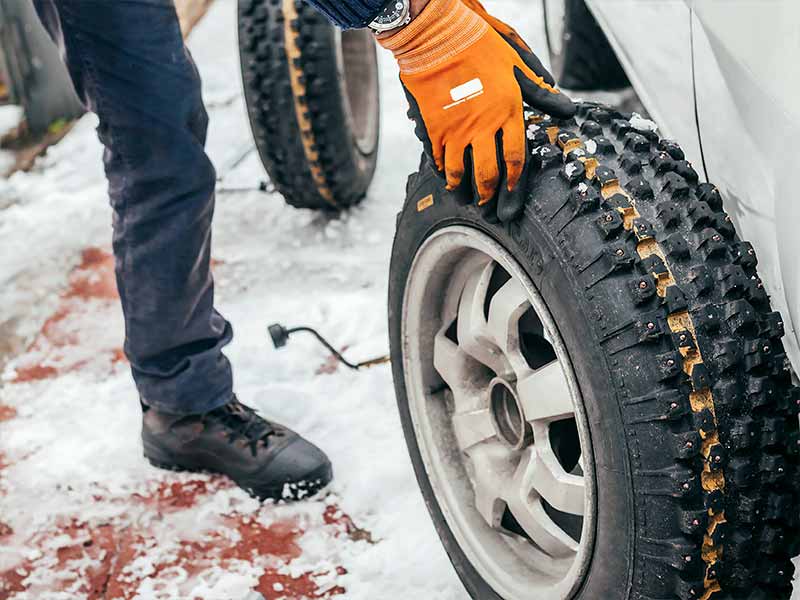
Wear and Tear of Studded Tires
While studded tires are invaluable for winter driving, their use on dry pavement can lead to faster wear and reduced effectiveness. Regular maintenance and mindful use can help prolong their life, ensuring they’re ready to perform when winter conditions demand it. Let me share some insights on this matter.
How Dry Pavement Affects Studded Tires
Studded tires are primarily designed for icy and snowy conditions. When used on dry pavement, several things can happen:
- Faster Wear of Studs: The metal studs in the tires can wear down more quickly on dry roads. This is because the hard surface causes more friction against the studs.
- Reduced Effectiveness: As the studs wear down, their ability to grip ice and snow diminishes, reducing the overall effectiveness of the tire in winter conditions.
Addressing the Question: Do Studded Tires Wear Out Faster on Dry Pavement?
To put it simply, yes, studded tires do tend to wear out faster on dry pavement. Here’s why:
- Increased Friction: The studs are designed to bite into ice, not asphalt. On dry roads, the friction between the studs and the pavement is higher, leading to quicker wear.
- Impact on Roads: Besides wearing out the studs, driving on dry pavement can also cause more wear and tear on the roads themselves.
Maintenance Tips for Prolonging the Life of Studded Tires
To get the most out of your studded tires, consider these maintenance tips:
- Use Only in Winter: Try to use studded tires only during the winter months or when you’re sure to encounter ice and snow.
- Regular Inspections: Check your tires regularly for stud wear and tire damage. This can help you gauge when it’s time to replace them.
- Proper Storage: When not in use, store your studded tires in a cool, dry place away from direct sunlight to prevent the rubber from degrading.
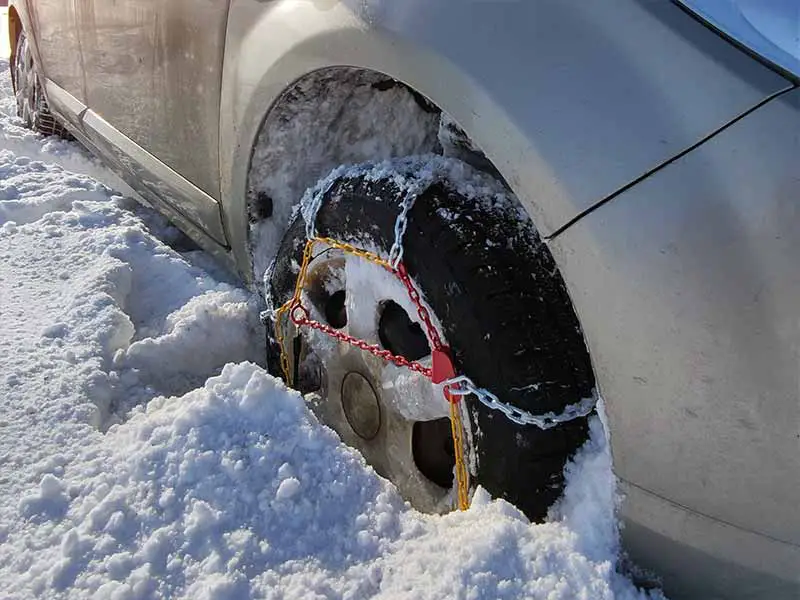
Alternatives to Studded Tires
While studded tires are excellent for certain winter conditions, they’re not the only option. Studless snow tires and tire chains can provide adequate winter traction for many drivers, depending on their specific needs and driving environments. Let’s look at some of these options.
Studless Snow Tires
Studless snow tires are a popular alternative to studded tires. Here’s what makes them a good choice for many drivers:
- Advanced Rubber Compounds: These tires use special rubber that stays flexible in cold temperatures, providing better grip on snow and ice.
- Unique Tread Patterns: The tread is designed to channel snow and slush and reduce the risk of hydroplaning.
- Quieter Ride: Without metal studs, studless snow tires are generally quieter on the road.
Tire Chains
Another alternative, especially for occasional use in severe conditions, are tire chains. They offer:
- Temporary Traction Boost: Tire chains can be put on your regular tires to provide extra grip in deep snow or ice.
- Flexibility: They’re a good option if you only occasionally drive in severe winter conditions, as they can be removed when not needed.
- Cost-Effectiveness: Tire chains can be more cost-effective than buying a separate set of winter tires.
When to Choose Studless Winter Tires Over Studded Tires
Choosing between studless winter tires and studded tires depends on your driving environment:
- Milder Winter Conditions: If you live in an area with moderate winter conditions, studless snow tires might be sufficient.
- Urban Driving: For city driving where roads are often cleared of snow quickly, studless tires can offer a good balance of performance and comfort.
- Noise and Road Wear Considerations: If you’re concerned about the noise and road wear associated with studded tires, studless tires are a quieter and more road-friendly option.
Legal Considerations and Regional Variations
Understanding and adhering to the legal considerations and regional variations of studded tire use is essential for every driver. It ensures not only your safety but also helps you avoid legal issues. Always stay informed about the regulations in your area and choose your winter tires accordingly. Let’s delve into the legal considerations and regional variations regarding studded tires.
Understanding Legal Restrictions
When it comes to studded tires, the first thing to check is the law in your area:
- Varied Regulations: Laws about studded tires can vary significantly from one region to another. Some places allow them only during certain months, while others may ban them entirely.
- Check Local Laws: Always verify the regulations in your state or country before using studded tires. This information is often available on local government or transportation websites.
Regional Variations in Studded Tire Usage
The use of studded tires is often influenced by the typical winter conditions in a region:
- Severe Winter Regions: In areas with harsh winter conditions, like heavy snowfall and frequent ice, studded tires are often legal and widely used.
- Milder Climates: In regions with milder winters, the use of studded tires might be restricted or unnecessary.
Legal Time Frames for Studded Tires
Many regions that allow studded tires set specific time frames for their use:
- Winter Months: Commonly, the legal period for using studded tires aligns with the typical winter months in the region.
- Fixed Dates: Some places have fixed dates, such as allowing studded tires from November 1st to April 1st.
Resources
Below are some links you may find helpful when learning about tires:
- Winter driving tips – National Highway Traffic Safety Administration
- What are winter tire studs – Tire Buyer
Final Thoughts
Studded tires are not designed for high-speed driving and are most effective when used within their recommended speed limits. Also, consider the legal aspects and regional regulations regarding studded tires to ensure compliance and safety.
Alternatives like studless snow tires and tire chains can also be effective, depending on your specific winter driving conditions. The key takeaway is to choose the right tire for your needs, keeping safety as the top priority.
Good luck and happy motoring.
